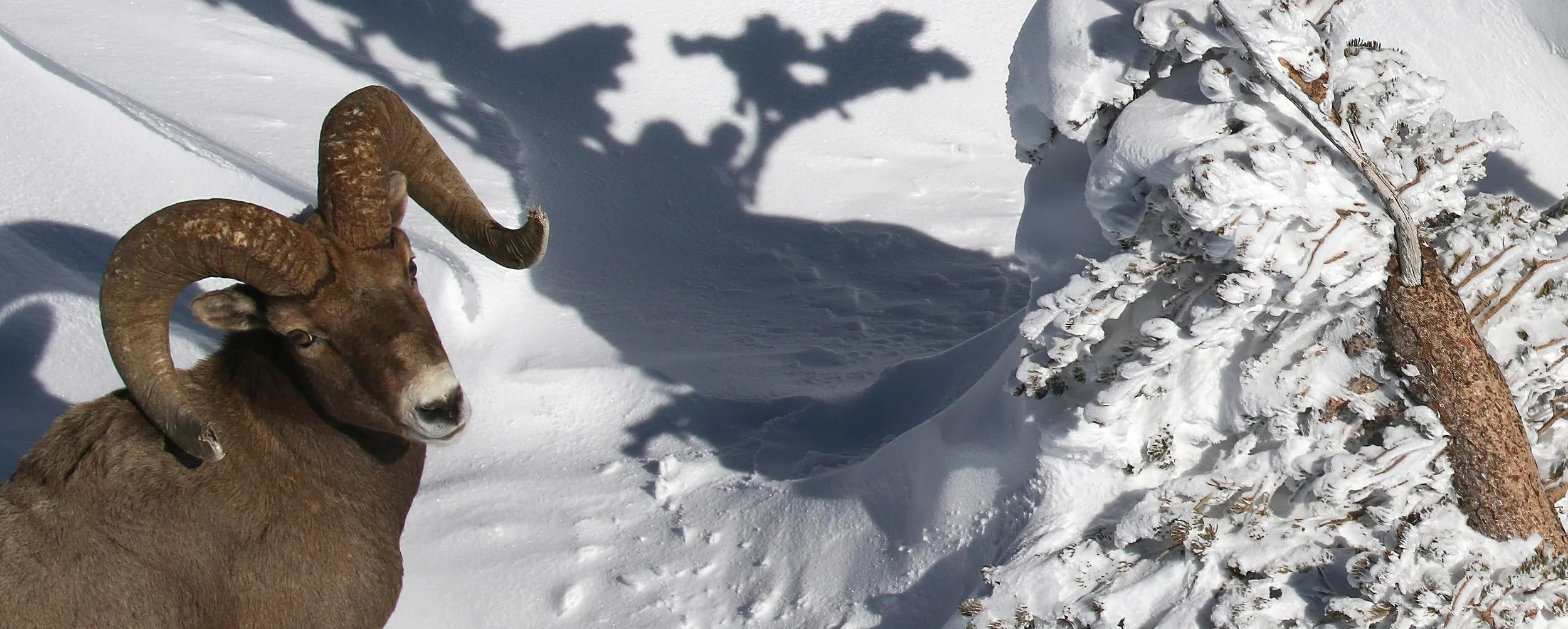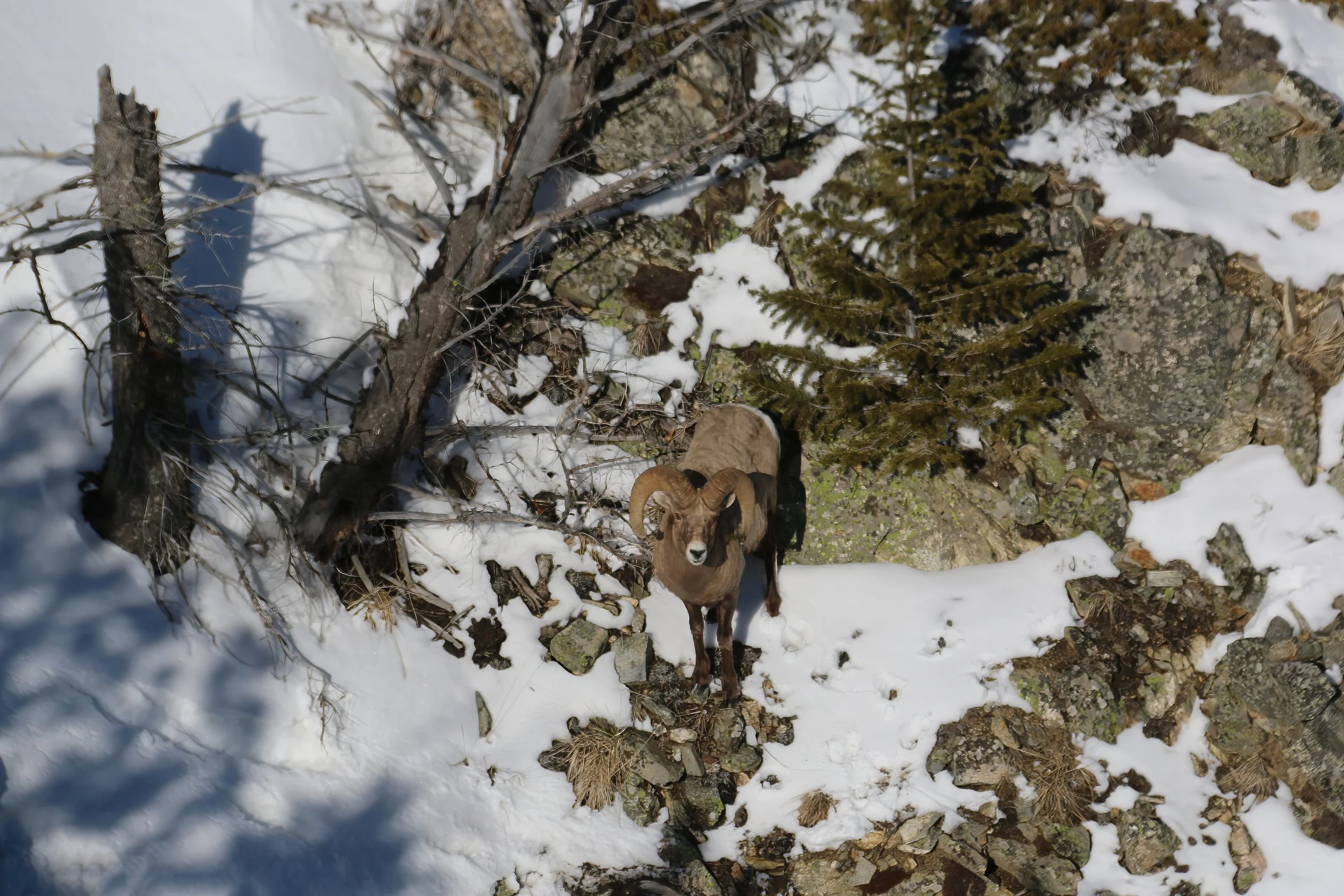OVERVIEW
The Teton Range provides excellent wildlife habitat and spectacular opportunities for outdoor recreation and experiences. Land and wildlife managers strive to balance those values. Today, there is increased concern about the future of bighorn sheep in the Tetons, as local experts are concerned the population is at risk.
A small, isolated herd of native bighorn sheep resides in the Teton Range. This population has permanently lost access to its traditional migration routes and low elevation winter ranges due to human development.
The population survives the winter living in the rugged high country, enduring severe winter conditions. Winters can be especially hard on 8-month old lambs and pregnant ewes.
Recent winter aerial surveys have documented approximately 100 sheep in the population. Preliminary results from a new population estimation technique using DNA indicates there may be about 175 sheep.
This is a small, native population of bighorn sheep with unique genetics and is at risk of local extinction.
Long-term fire suppression has also affected habitat quality and blocked access to some low elevation winter ranges.
Scientists have documented that Teton bighorn sheep avoid areas frequented by winter recreationists. In some cases, sheep have effectively lost up to 30% of the best winter habitat in the high country because of this displacement. Bighorn sheep that share winter habitat with humans frequently move to avoid them, burning energy, which can potentially result in starvation and poor reproduction.
The historical loss and alteration of important winter habitats have made the herd especially vulnerable; additional factors such as disturbance from winter backcountry recreation and an expanding non-native mountain goat population now pressure the herd’s survival even further.
Learn more about Winter Recreation here
CONSERVATION MEASURES
The working group has coordinated conservation measures, research, and monitoring of this bighorn sheep herd for the past three decades. Wildlife and resource managers from the National Park Service, U.S. Forest Service, and Wyoming Game and Fish Department have a responsibility to ensure the future of the Teton bighorn sheep population.
Current Work
Education and stewardship campaign to raise awareness about the status and threats to Teton bighorn sheep
Community collaborative process to identify and develop solutions that balance bighorn sheep winter habitat needs with continued winter recreation access
Removal of non-native mountain goats from the Teton Range. Mountain goats can spread diseases to bighorn sheep and compete for limited habitat.
Grand Teton National Park developed a management plan to address this issue within the park and lethally removed mountain goats over several years using a combination of skilled volunteers on the ground and aerial removal.
In parallel, the Wyoming Legislature passed legislation that allowed for a new type of mountain goat license and the Wyoming Game and Fish Department and Wyoming Game and Fish Commission created a new mountain goat hunting season outside of the park with the goal of completely removing mountain goats from the Teton Range.
Developing a new mark-recapture population estimation technique using DNA collected from bighorn sheep fecal samples at natural mineral licks in the Tetons.
Implementing prescribed burns and mechanical treatments for the Teton Canyon Hazardous Fuels Project on Caribou-Targhee National Forest, which will improve historical bighorn sheep winter habitat. This is one of the few opportunities we have to increase the amount of bighorn sheep winter habitat in the Tetons.
Annual helicopter survey flights to collect data on population trend, age/sex ratios, and distribution.
Providing technical comments and data for the Grand Targhee Resort Expansion Proposal on Caribou-Targhee National Forest.
Past Work
Research partnership with the Wyoming Cooperative Fish and Wildlife Research Unit at the University of Wyoming to study Teton bighorn sheep seasonal resource selection, movements, summer diet, summer lamb survival, cause of death, and the effects of winter recreation.
Research partnership with University of Montana to study the genetic diversity and connectedness of the herd within itself and with surrounding bighorn sheep herds.
Content collaboration and fundraising with director and producer of Denizens of the Steep film
Project collaring bighorn sheep and mountain goats, including state-of-the-art disease testing for pneumonia pathogens and experimentally deploying remote cameras to estimate population numbers and lamb survival.
Domestic sheep allotments in the Tetons were voluntarily closed with economic incentives provided to allotment permittees, effectively mitigating the risk of disease transmission from domestic sheep to bighorn sheep.
Provided technical comments and data for several proposals by Jackson Hole Mountain Resort on Bridger-Teton National Forest.
Wyoming Game and Fish Department reduced bighorn sheep hunting licenses from 7 in the 1980s to 1 today in Hunt Area 6 outside of Grand Teton National Park.
Two areas of Grand Teton National Park were closed to human entry in the winter: the summit area of Static Peak ( ~1990) and the Mount Hunt/Prospectors Mountain complex (2001) to help conserve bighorn sheep.
Prescribed burn in Darby Canyon on Caribou-Targhee National Forest to benefit bighorn sheep habitat.




